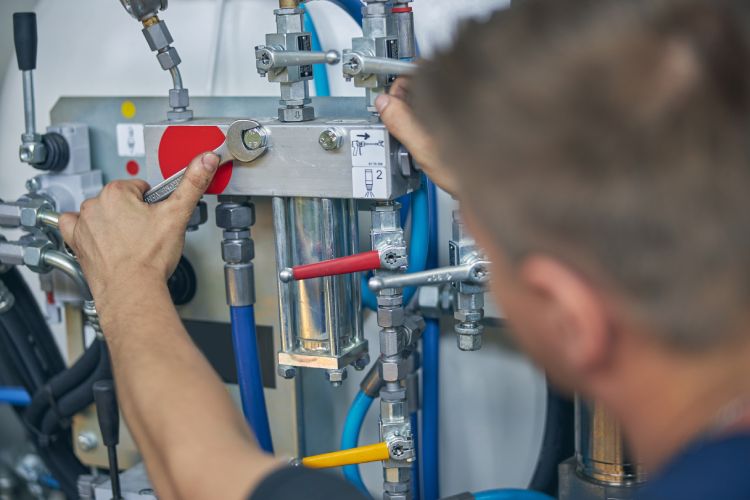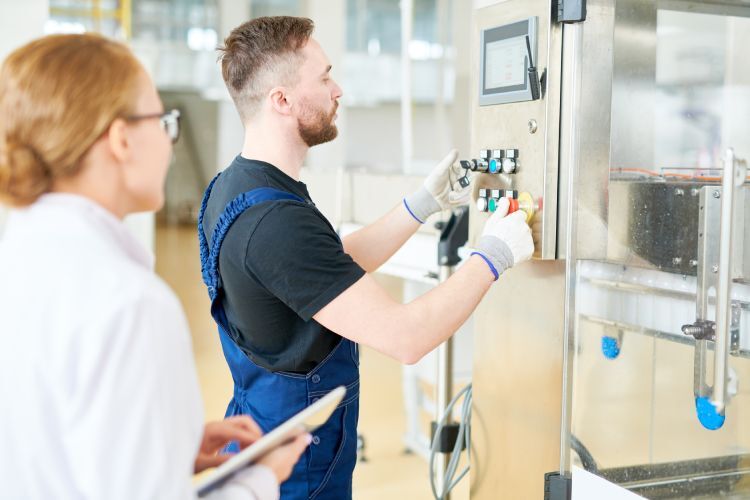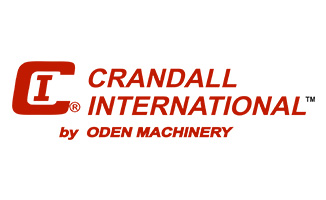
Liquid filling machines are the backbone of countless production lines, from food and beverages to pharmaceuticals and cosmetics. However, while these machines are built for efficiency and accuracy, they can sometimes face problems that slow production or compromise product quality. The key is knowing what to watch for, how to troubleshoot quickly, and when to call in expert support.
10 Common Filling Machine Problems & How to Solve Them
Every production line operator knows that even the most advanced liquid filling equipment can encounter setbacks. Whether it’s a minor drip or a complete halt in operations, these issues can disrupt schedules, increase costs, and frustrate teams.
Understanding the most common problems in detail not only prepares you to fix them quickly but also helps you prevent them from happening again.
Problem #1: Inconsistent Filling Levels
When containers don’t match in fill volume, production can suffer from both waste and dissatisfied customers.
Inconsistent filling levels hurt efficiency, impact uniformity, degrade appearance, and also risk compliance violations in regulated industries such as pharmaceuticals or food packaging. Over time, even small variations in fill levels can erode consumer trust and brand reputation.
The Cause
Inconsistent fills often result from inaccurate calibration, worn or damaged seals, or malfunctions within the pump system. Changes in viscosity due to environmental factors like temperature shifts may further disrupt fill levels. Even operator error, such as setting incorrect fill parameters, can contribute to the problem.
The Solution
To correct this issue, recalibrate equipment at consistent intervals and replace seals before they become brittle or worn. Perform pump maintenance to ensure consistent performance across production runs. Monitor the viscosity of products and adjust fill settings accordingly, creating a proactive process that minimizes discrepancies.
Problem #2: Leakage & Nozzle Dripping
Leaks and nozzle drips create messes that slow production and lead to unnecessary product loss. Left unchecked, leaks can also pose safety hazards by creating slippery floors and potential contamination risks.
Remember that minor leaks can escalate quickly if not addressed, so solving this issue should be a top priority.
The Cause
Leakage is commonly caused by deteriorated seals, malfunctioning valves, or poor nozzle shutoff mechanisms. Inadequate pressure control can also create conditions where liquid escapes during or after filling. Even slight nozzle misalignment can encourage persistent dripping.
The Solution
Replace seals and valves as soon as signs of wear appear to prevent further damage. Double-check nozzle alignment during setup and operation to reduce irregular dripping. Adjust air and liquid pressure settings carefully to match product properties, and include these checks as part of regular preventive maintenance.
Problem #3: Air Bubbles & Foaming
Foam or air bubbles in filled containers not only compromise product quality but also give a poor impression to consumers. Excess air creates inconsistencies in volume, and foam can impact shelf stability for certain products.
Unfortunately, this issue can become a recurring challenge if not properly addressed.
The Cause
Air bubbles usually form when liquid is filled too quickly, pumps run at inappropriate speeds, or product transfer introduces turbulence. Liquids that naturally foam, such as detergents or carbonated beverages, are even more prone to this problem. Poor equipment settings can also exacerbate aeration.
The Solution
Reduce fill speeds to allow product to settle more smoothly into containers. Adjust pump settings to minimize turbulence and redesign transfer systems to limit aeration. In certain cases, specialized nozzles or anti-foam equipment may be necessary to keep the final product clear and consistent.
Problem #4: Slow Production Speed
When equipment fails to match expected throughput, entire production lines suffer delays and bottlenecks.
Reduced speed means lower output, missed deadlines, and in some industries, lost contracts. For facilities with tight schedules, even a modest slowdown can cause cascading problems.
The Cause
Slowdowns are often tied to mechanical wear, poorly optimized settings, or clogged components. Electrical inefficiencies and outdated control systems may also play a role. Neglecting preventive maintenance typically makes these problems worse over time.
The Solution
Adhere to a strict preventive maintenance schedule to keep machines operating at optimal capacity. Clean machines thoroughly and frequently to avoid buildup that slows down performance. Optimize electrical systems and confirm that machine parameters align with product specifications to maximize speed without compromising accuracy.
Problem #5: Hygiene & Contamination Issues
For industries such as pharmaceuticals, beverages, or cosmetics, hygiene is paramount. Contamination can result in product recalls, legal action, and long-term damage to brand credibility.
Beyond compliance, cleanliness directly impacts consumer safety.
The Cause
Poor cleaning practices, residue buildup, and unhygienic equipment design all contribute to contamination risks. Neglected maintenance schedules make these conditions more likely, and machines without sanitary construction materials also exacerbate hygiene concerns.
The Solution
Establish and enforce strict cleaning protocols tailored to your product type and industry regulations. Choose machines made with stainless steel or other hygienic materials that are easy to clean. Incorporate sanitation checks into daily operations, and schedule deep cleans to minimize contamination risks.
Problem #6: Pump or Pressure Mishaps
When liquid flow is inconsistent or weak, pump and pressure system failures are often responsible.
Inaccurate fills or sudden stoppages due to pressure issues disrupt production efficiency. This problem can be especially damaging if not identified early.
The Cause
Pump problems may arise from worn components, incorrect pressure settings, or clogs in the lines. Over time, wear reduces efficiency and leads to erratic performance. Failure to service pumps regularly makes them more vulnerable to breakdowns.
The Solution
Inspect pumps frequently for wear, and replace damaged components before they fail completely. Adjust pressure systems to match the unique requirements of each liquid, and avoid under- or over-pressurization. Clear obstructions in the lines immediately to restore steady product flow and prevent production halts.
Problem #7: Container Misalignment & Jams
Poorly aligned containers cause spillage, uneven fills, and potential equipment damage. When jams occur, they stop production altogether, leading to downtime and wasted labor hours.
This issue, though seemingly simple, has wide-reaching effects on efficiency for your entire packaging line.
The Cause
Misaligned conveyors, defective guide rails, or worn moving parts typically create misalignment issues. Improper container placement by operators can also be a factor. Without corrections, the problem worsens as more containers are processed incorrectly.
The Solution
Realign conveyor systems and replace any guide rails or mechanical parts that show wear. Train operators to properly load containers, ensuring smooth transitions along the production line. Incorporate alignment checks into routine inspections to prevent small misalignments from becoming major disruptions.
Problem #8: Capping & Sealing Issues
Caps that are loose, crooked, or improperly sealed create risk of leaks, spoilage, and consumer complaints. In many cases, this problem leads to returns and lost revenue. It also compromises product shelf life and regulatory compliance.
The Cause
Misaligned caps, defective capping heads, and torque calibration errors are the most common culprits of capping and sealing issues. Inconsistent container shapes or improperly manufactured caps can add to the problem. Without intervention, defective sealing quickly undermines production quality.
The Solution
Recalibrate torque settings regularly and inspect capping heads for wear or damage. Verify that caps and containers are compatible and consistently manufactured to reduce variability. Proactive inspections help catch sealing issues before they compromise an entire batch.
Problem #9: Overheating & Electrical Failures
Electrical issues and overheating stop production abruptly and create risks for both operators and equipment.
Overheated machines are more likely to sustain permanent damage if the issue persists. Prolonged electrical failures also introduce fire hazards and compliance concerns.
The Cause
Faulty wiring, poor ventilation, or overloaded electrical circuits typically contribute to overheating. Aging electrical components may fail under strain. In some cases, insufficient cooling systems worsen the situation.
The Solution
Improve ventilation systems to keep machines running at safe temperatures. Inspect wiring regularly for signs of wear, loose connections, or damage, and replace outdated components. Avoid overloading circuits, and schedule electrical audits to identify potential hazards before they lead to downtime.
Problem #10: Sensor & Detection Errors
Sensors provide critical automation support and confirm that containers are filled, sealed, and processed correctly. When sensors fail, misreads and production stoppages become frequent. This type of error creates inefficiency, causes confusion, and increases the risk of product waste.
The Cause
Dirty sensors, misalignment, or internal defects can lead to faulty readings. Environmental factors such as dust or humidity may further impair sensor accuracy. Additionally, sensors that are not recalibrated routinely are more likely to fail.
The Solution
Clean sensors regularly and keep them free of debris or dust buildup. Recalibrate sensors as part of routine maintenance to ensure consistent accuracy. Replace defective sensors promptly, as failing to do so can compromise automated operations and lead to costly downtime.

Troubleshooting Tips for Liquid Filling Machines
Troubleshooting isn’t just about solving problems after they arise. It also requires knowing where to look first and avoiding unnecessary downtime. By methodically approaching issues and being proactive, you can save time and resources while ensuring consistent performance.
Start with the Basics
Before diving into complex technical fixes, always confirm the simplest details first. Make sure the machine is connected to a stable power source, the switches are in the proper position, and the product supply is adequate. Many times, operators overlook these initial checks, leading to wasted effort exploring more complicated solutions.
By ruling out these small but fundamental issues, you set the stage for more focused troubleshooting and avoid unnecessary confusion. This habit of starting simple can save valuable time in fast-paced production environments.
Listen & Observe
A machine often gives early warnings before a major failure, and it’s up to the operator to catch them.
Unusual grinding, rattling, or knocking sounds may suggest worn bearings, while an odd smell could indicate overheating electrical wires. Even subtle vibrations can reveal hidden mechanical imbalances.
Training your staff to tune into these sensory clues builds a proactive culture of observation. Over time, these small observations can become your strongest line of defense against costly breakdowns.
Keep Spare Parts on Hand
Having replacement parts immediately available can mean the difference between a quick repair and hours—or even days—of lost productivity. Items like seals, nozzles, gaskets, and sensors are common points of failure and should be kept in stock at all times.
Waiting on parts from a supplier during an emergency can paralyze production. Building an organized, accessible parts inventory not only reduces downtime but also reassures your team that solutions are within reach. This forward-thinking approach is an investment in continuity and peace of mind.
Follow Maintenance Schedules
Preventive maintenance may seem time-consuming, but it is always more cost-effective than reactive repairs. Sticking to a regular schedule ensures that small issues, such as loose bolts or clogged lines, are addressed before they escalate.
Consistency in maintenance reduces the frequency of unexpected stoppages and extends the life of expensive components. Furthermore, it builds confidence within the production team that equipment will perform reliably during peak demand.
Ultimately, maintenance schedules are less about routine and more about long-term operational stability.
Check Product Properties
Liquids differ significantly, and machines must be adjusted accordingly. A thin liquid may fill too quickly, while a thicker one could clog or slow down production. Even changes in temperature can alter viscosity and impact how a product behaves in the machine.
By continuously monitoring product characteristics and tweaking machine parameters, you ensure smooth operations. This adaptability is crucial for companies that handle a wide variety of products or regularly introduce new formulations.
How to Identify Filling Machine Problems Early
Early detection is the difference between a quick adjustment and a costly shutdown. Alternatively, catching small issues before they escalate means operators can reduce downtime and protect product quality.
Conduct Regular Inspections
Daily or weekly inspections are the simplest yet most effective defense against unexpected failures.
By walking around the equipment and looking for leaks, unusual residue, or cracks, operators can spot signs of wear long before they cause real trouble. These inspections also build familiarity with the equipment, making deviations easier to notice over time. Consider using a structured checklist to help maintain consistency and prevent critical areas from being overlooked.
In short, what takes just a few minutes per day can save countless hours of unplanned downtime later.
Monitor Performance Consistently
Consistently tracking machine performance provides a reliable benchmark of normal operations. If operators record fill volumes, cycle times, and output levels, they can quickly spot deviations that signal potential issues. For example, a gradual decline in fill accuracy may indicate calibration drift, while sudden drops in speed could mean component wear.
Anomalies are much easier to correct when caught early, and monitoring tools make this process straightforward. The data becomes a roadmap that guides timely interventions and minimizes disruptions.
Perform Quality Control Checks
Finished products serve as the ultimate indicator of machine health. You can catch discrepancies in volume, sealing, or labeling if you regularly sample and inspect filled containers. Even small irregularities may point to underlying equipment problems that need attention.
Incorporating these checks into daily operations ensures consistency across batches and strengthens customer trust. Over time, a disciplined quality control process builds both efficiency and reliability.
Leverage Data & Sensors
Smart sensors and digital monitoring systems take early detection to a new level. These technologies provide real-time feedback on temperature, pressure, and performance metrics that humans may miss. When anomalies occur, alerts can be set up to notify operators instantly, allowing for rapid response.
The ability to collect and analyze this data also creates opportunities for predictive maintenance, where potential failures are addressed before they occur.
When to Contact an Expert for Help with Liquid Filling Machines
Some issues go beyond what on-site staff can resolve. While troubleshooting and preventive care can cover a wide range of scenarios, there are times when expert intervention is the most efficient, cost-effective option:
- If problems persist even after thorough troubleshooting
- If electrical or software malfunctions are suspected
- If production downtime is critical and extended delays are unacceptable
- If specialized upgrades, adjustments, or custom parts are required
- If safety concerns arise that exceed in-house expertise
- If the machine is due for a comprehensive performance audit
Expert technicians have the experience, specialized tools, and deep product knowledge to address issues that general staff may miss.
Bringing in an expert ensures the problem is resolved correctly and can also reveal hidden opportunities to improve efficiency. In many cases, contacting an expert early prevents more expensive breakdowns later and protects your bottom line.
Frequently Asked Questions About Filling Machine Problems & Solutions
Even with comprehensive documentation and field expertise, operators often have specific questions about handling equipment issues. This FAQ section addresses some of the most common queries to provide quick, actionable insights that complement the troubleshooting strategies shared earlier.
Why Is My Filling Machine Leaking?
Leaks often stem from worn seals, faulty valves, or misaligned nozzles. Check these components first, and replace them if needed. Adjusting pressure settings and ensuring proper nozzle shutoff can also help resolve leakage issues.
How Do I Fix Inconsistent Fill Levels?
Start by recalibrating the machine to confirm its settings are accurate. Inspect seals, pumps, and sensors for wear or malfunction. Consider product viscosity changes and adjust parameters accordingly.
What Causes Air Bubbles or Foaming in Filled Products?
High fill speeds, incorrect pump operation, or turbulence during product transfer often introduce air. Slowing the fill rate, adjusting pump settings, or using specialized nozzles can significantly reduce foam.
When Should I Replace Sensors on My Liquid Filling Machine?
If sensors consistently misread containers despite cleaning and recalibration, they may be defective and require replacement. Routine inspections help catch failing sensors before they disrupt production.
What Preventive Steps Can I Take to Avoid Downtime?
Follow a strict maintenance schedule, train staff to recognize warning signs, and keep critical spare parts on hand. Regular inspections, quality control checks, and performance monitoring all help detect problems early.
Keep Your Production Line Running Smoothly with Oden Machinery
Keeping liquid filling machines running efficiently is critical for profitability. By understanding common problems, identifying their causes, and acting on proven solutions, operators can protect both product quality and output. And remember that preventive maintenance and early detection reduce risks, while knowing when to bring in professional support is important for long-term reliability.
Ready to eliminate downtime and get the most from your liquid filling equipment? Contact Oden Machinery today for expert advice, professional troubleshooting, and top-of-the-line liquid filling machines designed to keep your operation running at its best. Our team is here to provide the support, parts, and solutions you need to stay ahead of production challenges.

